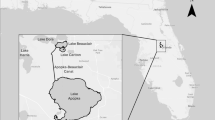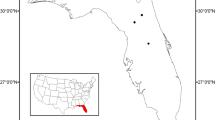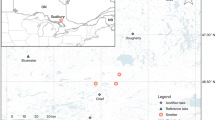Abstract
In the region northeast of Wawa, Ontario (Canada), many circumneutral lakes downwind of a nearby iron-sintering plant were strongly acidified (pH 3–4) in response to the emissions of large amounts of sulfur dioxide from 1939–1998. Following closure of the plant in 1998, lakewater pH has returned to circumneutral conditions due to the high buffering capacity of the local geological substrate. Prior paleolimnological analyses of dated sediment cores have detected some biological recovery among algal communities (diatoms and chrysophytes), although they have not returned to their pre-impact assemblages. Here we take a broader ecosystem approach, and build upon the algal analyses by examining cladoceran sedimentary assemblages, and spectrally-inferred chlorophyll a and dissolved organic carbon (DOC) from the same dated sediment cores. Similar to the algal communities, recent cladoceran sedimentary assemblages from three impacted lakes remain in an altered state relative to the pre-impact period (for example, increased relative abundances of Chydorus brevilabris and reduced cladoceran density in sediments). However, trends in the spectrally-inferred chlorophyll a and DOC were mixed, with long-term decreases in the study lake closest to the plant and long-term increases within the other lakes. Collectively, the multi-proxy paleolimnological analyses of these markedly acidified lakes demonstrate the delayed biological recovery from acidification (and differences in timing) across multiple trophic levels, despite the near-elimination of acid deposition almost a decade previously, which led to a striking recovery in lakewater pH and increased food availability.








Similar content being viewed by others
References
Arnott SE, Yan ND. 2002. The influence of drought and re-acidification on zooplankton emergence from resting stages. Ecol Appl 12:138–53.
Arseneau KMA, Driscoll CT, Brager LM, Ross KA, Cumming BF. 2011. Recent evidence of biological recovery from acidification in the Adirondacks (New York, USA): a multiproxy paleolimnological investigation of Big Moose Lake. Can J Fish Aquat Sci 68:575–92.
Bennett KD. 1996. Determination of the number of zones in a biostratigraphical sequence. New Phytol 132:155–70.
Belyaeva M, Denecke R. 2007. Colonization of acidic mining lakes: Chydorus sphaericus and other Cladocera within a dynamic horizontal pH gradient (pH 3–7) in Lake Senftenberger See (Germany). Hydrobiologia 594:97–108.
Brooks JL, Dodson SI. 1965. Predation, body size, and composition of plankton. Science 150:28–35.
Cattaneo A, Couillard Y, Wunsam S, Courcelles M. 2004. Diatom taxonomic and morphological changes as indicators of metal pollution and recovery in Lac Dufault (Québec, Canada). J Paleolimnol 32:163–75.
DeSellas AM, Paterson AM, Sweetman JN, Smol JP. 2011. Assessing the effects of multiple environmental stressors on zooplankton assemblages in Boreal Shield lakes since pre-industrial times. J Limnol 70:41–56.
Fischer JM, Olson MH, Williamson CE, Everhart JC, Hogan PJ, Mack JA, Rose KC, Saros JE, Stone JR, Vinebrooke RD. 2011. Implications of climate change for Daphnia in alpine lakes: predictions from long-term dynamics, spatial distribution, and a short-term experiment. Hydrobiologia 676:263–77.
Frey DG. 1980. On the plurality of Chydorus sphaericus (O.F. Müller) (Cladocera, Chydoridae), and designation of a neotype from Sjaelsø Denmark. Hydrobiologia 69:83–123.
Frey DG. 1986. Cladocera Analysis. In: Berglund BE, Ed. Handbook of Holocene palaeoecology and palaeohydrology. New York: Wiley. p 667.
Glew JR. 1988. A portable extruding device for close interval sectioning of unconsolidated core samples. J Paleolimnol 1:235–9.
Glew JR. 1989. A new trigger mechanism for sediment samplers. J Paleolimnol 2:241–3.
Goodwin AM. 1964. Geochemical studies at the Helen iron range. Econ Geol 59:684–718.
Gordon AG, Gorham E. 1963. Ecological aspects of air pollution from an iron-sintering plant at Wawa, Ontario. Can J Bot 41:1063–78.
Graham MD, Vinebrooke RD, Keller B, Heneberry J, Nicholls KH, Findlay DL. 2007. Comparative responses of phytoplankton during chemical recovery in atmospherically and experimentally acidified lakes. J Phycol 43:908–23.
Greenaway CM. 2009. Diatom community responses to water quality improvements in lakes recovering from acidification and metal-contamination near Wawa, Ontario, Canada: a paleolimnological perspective. M.Sc. Thesis. Canada: Queen’s University.
Greenaway CM, Paterson AM, Keller W, Smol JP. 2012a. Dramatic diatom species assemblage responses in lakes recovering from acidification and metal-contamination near Wawa, Ontario, Canada: a paleolimnological perspective. Can J Fish Aquat Sci 69:656–69.
Greenaway CM, Paterson AM, Keller W, Smol JP. 2012b. Scaled-chrysophyte assemblage changes in the sediment records of lakes recovering from marked acidification and metal contamination near Wawa, Ontario, Canada. J Limnol 71:267–78.
Grimm EC. 1987. CONISS: A Fortran 77 program for stratigraphically constrained cluster analysis by the method of incremental sum of squares. Comput Geosci 13:13–35.
Hamza W, Bonacina C, Canale C. 1998. Side effects of water liming on body size and eggs development of Daphnia species in Lake Orta (N. Italy). Hydrobiologia 368:129–36.
Hann BJ, Turner MA. 1999. Exploitation by microcrustacea of a new littoral habitat in an acidified lake. Hydrobiologia 416:65–75.
Havens KE, Yan ND, Keller W. 1993. Lake acidification: effects on crustacean zooplankton populations. Environ Sci Technol 27:1621–4.
Hessen DO, Faafeng BA, Andersen T. 1995. Replacement of herbivore zooplankton species along gradients of ecosystem productivity and fish predation pressure. Can J Fish Aquat Sci 52:733–42.
Jeffries DS, Clair TA, Couture S, Dillon PJ, Dupont J, Keller W, McNicol DK, Turner MA, Vet R, Weeber R. 2003. Assessing the recovery of lakes in southeastern Canada from the effects of acidic deposition. AMBIO 32:176–82.
Jeffries DS, McNicol DK, Weeber RC, editors. 2004. Canadian acid deposition science assessment. Chapter 6: Effects on aquatic chemistry and biology. Environment Canada, Ottawa, Canada.
Jeziorski A, Paterson AM, Smol JP. 2012. Crustacean zooplankton sedimentary remains from calcium-poor lakes: complex responses to threshold concentrations. Aquat Sci 74:121–31.
Keller W, Pitblado JR. 1984. Crustacean plankton in Northeastern Ontario lakes subjected to acidic deposition. Water Air Soil Poll 23:271–91.
Keller W, Pitblado JR. 1989. The distribution of crustacean zooplankton in Northern Ontario, Canada. J Biogeogr 16:249–59.
Keller W, Dixit SS, Heneberry J. 2001. Calcium declines in northeastern Ontario lakes. Can J Fish Aquat Sci 58:2011–20.
Keller W, Yan ND, Somers KM, Heneberry JH. 2002. Crustacean zooplankton communities in lakes recovering from acidification. Can J Fish Aquat Sci 59:726–35.
Keller W. 2009. Limnology in northeastern Ontario: from acidification to multiple stressors. Can J Fish Aquat Sci 66:1189–98.
Korhola A, Rautio M. 2001. Cladocera and other branchiopod crustaceans. In: Smol JP, Birks HJB, Last WM, Eds. Tracking environmental change using lake sediments, Vol. 4: zoological indicators. Dordrecht: Kluwer Academic Publishers. pp. 4–41.
Korosi JB, Burke SM, Thienpont JR, Smol JP. 2012. Anomalous rise in algal production linked to lakewater calcium decline through food web interactions. Proc R Soc B 279:1210–17.
Kurek J, Korosi JB, Jeziorski A, Smol JP. 2010. Establishing reliable minimum count sizes for cladoceran subfossils sampled from lake sediments. J Paleolimnol 44:603–12.
Kurek J, Weeber RC, Smol JP. 2011. Environment trumps predation and spatial factors in structuring cladoceran communities from Boreal Shield lakes. Can J Fish Aquat Sci 68:1408–19.
Michelutti N, Blais JM, Cumming BF, Paterson AM, Rühland K, Wolfe AP, Smol JP. 2010. Do spectrally inferred determinations of chlorophyll a reflect trends in lake trophic status? J Paleolimnol 43:208–17.
Neary BP, Dillon PJ, Munro JR, Clark BJ. 1990. The acidification of Ontario lakes: an assessment of their sensitivity and current status with respect to biological damage. Dorset: Ontario Ministry of the Environment.
Nilssen JP, Sandoy S. 1990. Recent lake acidification and cladoceran dynamics: Surface sediment and core analyses from lakes in Norway, Scotland and Sweden. Philos Trans R Soc B 327:299–309.
Oksanen J, Blanchet FG, Kindt R, Legendre P, O’Hara RB, Simpson GL, Solymos P, Stevens MHH, Wagner H. 2010. Vegan: Community Ecology Package. R package version 1.17-4 http://CRAN.R-project.org/package=vegan.
R Development Core Team. 2010. R: A language and environment for statistical computing. R Foundation for Statistical Computing, Vienna, Austria. ISBN 3-900051-07-0. http://www.R-project.org/.
Rouillard A, Rosén P, Douglas MSV, Pienitz R, Smol JP. 2011. A model for inferring dissolved organic carbon (DOC) in lakewater from visible-near-infrared spectroscopy (VNIRS) measures in lake sediment. J Paleolimnol 46:187–202.
Rowe JM. 1999. Heart of a Mountain, Soul of a Town: the story of Algoma Ore and the town of Wawa. Altona: Friesens.
Sage RP. 1994. Geology of the Michipicoten greenstone belt. Ontario Geological Survey. Open File Report 5888.
Smirnov NN. 1996. Cladocera: the Chydorinae and Sayciinae (Chydoridae) of the World. Amsterdam: SPB Academic Publishing.
Smith RA. 1872. Air and rain: the beginnings of a chemical climatology. London: Longmans, Green and Co.
Smol JP. 2010. The power of the past: using sediments to track the effects of multiple stressors on lake ecosystems. Freshwater Biol 55(Suppl. 1):43–59.
Somers KM. 1980. Alterations of lake fish communities in response to acid precipitation and heavy metal loading near Wawa, Ontario. M.Sc. Thesis. The University of Toronto, Toronto.
Somers KM, Harvey HH. 1984. Alteration of fish communities in lakes stressed by acid deposition and heavy metals near Wawa, Ontario. Can J Fish Aquat Sci 41:20–9.
Stokes PM. 1986. Ecological effects of acidification on primary producers in aquatic systems. Water Air Soil Poll 36:421–38.
Sweetman JN, Smol JP. 2006. Patterns in the distribution of cladocerans (Crustacea: Branchiopoda) in lakes across a north-south transect in Alaska, USA. Hydrobiologia 553:277–91.
Szeroczyńska K, Sarmaja-Korjonen K. 2007. Atlas of subfossil Cladocera from central and northern Europe. Świecie: Friends of the Lower Vistula Society.
Tropea AE, Paterson AM, Keller W, Smol JP. 2010. Sudbury sediments revisited: evaluating limnological recovery in a multiple-stressor environment. Water Air Soil Poll 210:317–33.
Valois A, Keller WB, Ramcharan C. 2010. Abiotic and biotic processes in lakes recovering from acidification: the relative roles of metal toxicity and fish predation as barriers to zooplankton re-establishment. Freshwater Biol 55:2585–97.
Wolfe AP, Vinebrooke RD, Michelutti N, Rivard B, Das B. 2006. Experimental calibration of lake-sediment spectral reflectance to chlorophyll a concentrations: methodology and paleolimnological validation. J Paleolimnol 36:91–100.
Yan ND, Strus R. 1980. Crustacean zooplankton communities of acidic, metal-contaminated lakes near Sudbury, Ontario. Can J Fish Aquat Sci 37:2282–93.
Yan ND, Keller W, Somers KM, Pawson TW, Girard RE. 1996. Recovery of crustacean zooplankton communities from acid and metal contamination: comparing manipulated and reference lakes. Can J Fish Aquat Sci 53:1301–27.
Yan ND, Girard R, Heneberry JH, Keller WB, Gunn JM, Dillon PJ. 2004. Recovery of copepod, but not cladoceran, zooplankton from severe and chronic effects of multiple stressors. Ecol Lett 7:452–60.
Acknowledgments
Support for this project was provided by the Ontario Ministry of the Environment, through the Climate Change and Multiple Stressor research program at Laurentian University, as well as through an NSERC grant to JPS. We thank Kim Sontag for performing the sedimentary chlorophyll a analyses, Amy Tropea for her assistance in the field and Don A. Jackson for prompting this work via his general observations of recovery in Wawa lakes.
Author information
Authors and Affiliations
Corresponding author
Additional information
Author Contributions
AJ conceived of or designed research, performed research, analyzed data, wrote paper. BK conceived of or designed research, wrote paper. AMP conceived of or designed research, wrote paper. CMG conceived of or designed research, performed research, wrote paper. JPS conceived of or designed research, wrote paper.
Rights and permissions
About this article
Cite this article
Jeziorski, A., Keller, B., Paterson, A.M. et al. Aquatic Ecosystem Responses to Rapid Recovery from Extreme Acidification and Metal Contamination in Lakes Near Wawa, Ontario. Ecosystems 16, 209–223 (2013). https://doi.org/10.1007/s10021-012-9603-6
Received:
Accepted:
Published:
Issue Date:
DOI: https://doi.org/10.1007/s10021-012-9603-6




